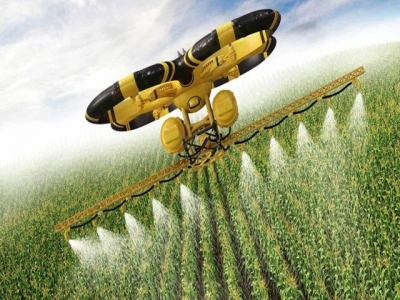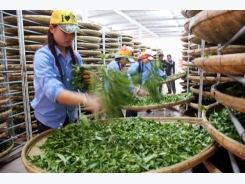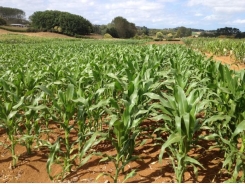Techno-culture in Farming

Over the decades, Indian agriculture has seen interventions of various elementary technologies. Now, the advance technologies such as space, remote sensing, drones, GPS and irrigation sensors are knocking the door.
In the recent decades, technological applications in agriculture have witnessed steady growth in India. The major role was played by farm mechanisation. Meanwhile, technological advancement in other areas of agriculture was also taking shape.
Technologies such as micro irrigation, biotechnology, soil health cards, mobile money and usage of mobile phones in various agricultural practices have already made footprints in India. Moreover, remote sensing, drones, global positioning system (GPS), digitised mapping among various other technologies are knocking the door of the sector.
Indian farmers are facing multiple challenges of erratic monsoon, high cost of agriculture inputs, poor access to credit, low price of produce, inadequate market access and many localised problems. Highlighting the methods to counter these challenges, Siraj Hussain, Secretary, Department of Agriculture and Cooperation, Ministry of Agriculture, says, “This is the need of the hour, not to just restrict to the farm mechanisation but we need to enlarge the horizon of advance technologies which can bring the changes in agriculture.”
Techno-culture
On the application of drones in agricultural practices, Dr R Chidambaram, Principal Scientific Advisor to Government of India, says, “Agricultural drones with appropriate sensors can be a good tool for crop management, increasing yield, managing irrigation water, applying pesticides and chemicals judiciously.”
While citing an example of NETRA, an unmanned aerial vehicle (UAV) developed by Defence Research and Development Organisation (DRDO) that was used to track damage and marooned people in devastating Uttarakhand floods, he says, “It can bring a big change in the agriculture sector too.”
The experts emphasise on the application of space technology and remote sensing data, taken from drones. There is a need to develop mechanism to assess the data received from the agricultural drones.
The National Remote Sensing Centre (NRSC) of Indian Space Research Organisation (ISRO) sells remote sensing data for agriculture sector.
Highlighting the relevance of advance technologies, Dr David Bergvinson, Director General, International Crops Research Institute for Semi-Arid Tropics (ICRISAT) says, “Advance technologies are very relevant and have the potential to address productivity challenges and overall growth of the sector.” He points out the need for an ecosystem of integrated services offered through public and private sectors, civil society and farmer organisations.
To overcome the challenges and feed the rising population, it has become a necessity to transform agriculture in scientific manner. Keeping in view the small landholding as 80 percent of Indian farmers are having lesser than two hectares of land, the technological interventions need to be inclusive for all.
Besides, 97 agriculture institutes and 4 deemed universities functioning under Indian Council of Agricultural Research (ICAR), 60 State Agricultural Universities and 2 Central Agricultural Universities are imparting agricultural education, research and training across the country. Thus, the country has tremendous potential to bring a big change in the farming sector. To bring the technological interventions, there is a need for academia, industry and other stakeholders to come together.
S Sivakumar, Chief Executive - Agribusiness division, ITC says that agriculture is at a crucial juncture – economic viability and dignity of labour are key concerns. He emphasises on the importance of technology in overcoming the challenges of erratic weather conditions, price risk, and drudgery of agriculture labour.
Agriculture, so far, has been the least attractive job for the youth. They rather prefer to migrate from the rural areas or moving towards non-farm jobs due to the low income and poor policy intervention in the sector. By transforming agriculture into techno-culture, it can be assured that the next generation looks at agriculture as an attractive enterprise.
“The urban youth is tech-savvy while only a little number of rural youth are familiar with it. We need to develop a dedicated rural curriculum for educating technological applications to the youth in the villages,” asserts Jang Bahadur Singh Sangha, Managing Director, Sangha Seeds.
Availability of advanced technology, scope for scaling up and replicating their adoption at the farm level, commercialisation of agriculture, incubation and financing of such technologies will create a platform to reiterate the need for moving on from mechanisation to technology adoption and its contribution to the overall growth and productivity enhancement.\t
Technology application in Indian agriculture is on the verge to attain heights by the consistent R&D and innovations, undertaken by the public as well as private sector. Advancements such as precision farming, satellite soil mapping and water conditions, hydroponics and innovative machineries that are energy efficient and adaptable to local conditions have proved their efficiency in the Indian farming sector. The focus is shifting towards creating better synergies between various stakeholders to ensure greater technology uptake.
Agriculture has to be the main pillar of Indian economy as more than half of the population in the country is dependent on it.
Dr. Vipin Kumar, Director & Chief Operating Officer, National Innovation Foundation emphasises on the development of localised technologies for better application. He further advocates for participatory research to ensure that the right technologies are being developed that have a problem-solving quotient.
Commercialising Technologies
Public as well as private sectors have been investing significantly in the R&D and developing new technologies to address the sustainable agriculture.
Considering the structural shift in agriculture and the increasing need for technologisation, ensuring that the technologies are available to the farmers and agribusiness players and are viable on ground and scalable is most critical. There is a lot of merit in strengthening the public private connect in this area, leveraging the respective competitive advantage. Of course, challenges related to commercialisation need to be addressed.
In commercialisation of technologies, the issue of Intellectual Property Rights becomes crucial. Dr Shashank Mauria, Assistant Director General (IP & Technology Management), ICAR, says, “Though the number is very less, but ICAR is the 3rd largest organisation which files for patent of technologies in India.” Citing an example of Israel, Dr Mauria adds, “Today, Israel has become the powerhouse of bringing advancement in agriculture as it has worked for IPR. We must become the powerhouse of IPR if we want to become the powerhouse of agriculture.”
Pointing out the flip side, Dr. Sanjeev Saxena, Principle Scientist, IP & TM Unit in the apex body of Indian agricultural research says, “R&D happens in the research organisations in the silos which are not connected with the market. Now, we have to move from innovation to inclusive innovation.”
Farm mechanisation
Increasing awareness among farmers about the benefits of mechanisation along with various government schemes implemented for its promotion has resulted in steady growth of farm mechanisation in India.
Commenting on the affordability of big size mechanisation, TR Kesavan, Chief Operating Officer - Product Strategy, Tractors and Farm Equipment (TAFE), says, “Every individual farmer cannot bring the machines to their field. Thus, the corporate sector can play vital role here by setting up custom hiring centres.”
With around 55 percent of population engaged in agriculture, India has, so far, achieved 40 percent of farm mechanisation. The remaining 60 percent landholding opens good opportunity that can be tapped with more focus towards mechanising small and marginal farmers with easier access to agricultural credit with improved affordability.
Stressing on the integration of mechanisation with small landholding, Ravindra Kumar, Managing Director, SAS Motors, states, “We need to understand the ecosystem of Indian agriculture. As the landholding is very low, we cannot sell tractors to the small and marginalised farmers. Thus, the affordable power tillers can bring the power to the farmers, having fragmented landholding.”
Mechanisation is like industrialisation that requires a level of scale among the farmers. The industry should focus into farmers’ training programmes for better application of farm mechanisation.
After intervention of many elementary technologies in farming sector, now time has moved to advance technologies. The policymakers, private sector, academia as well as researchers need to find out the optimal usage of advance technologies by making them accessible to the small and marginal farmers. It would necessarily bring changes in the farming sector as well as the overall economy.
Có thể bạn quan tâm
Phần mềm

Phối trộn thức ăn chăn nuôi

Pha dung dịch thủy canh

Định mức cho tôm ăn

Phối trộn phân bón NPK

Xác định tỷ lệ tôm sống

Chuyển đổi đơn vị phân bón

Xác định công suất sục khí

Chuyển đổi đơn vị tôm

Tính diện tích nhà kính

Tính thể tích ao hồ




 How Agriculture Technology Has Helped Feed Our Growing…
How Agriculture Technology Has Helped Feed Our Growing…  What’s next for agricultural biologicals
What’s next for agricultural biologicals